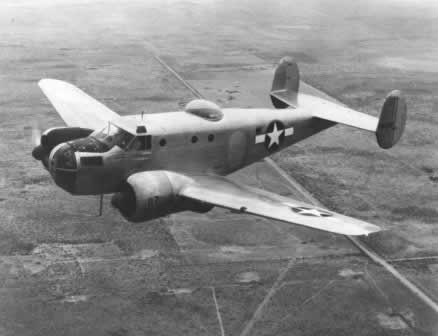
Beech Aircraft first introduced the Model 18 light, twin-engine, twin-tail, tail-dragger to the
civilian market in late 1937. Originally a 6 to 11 place civilian executive transport, the
aircraft became one of the most popular utility / cargo planes before WW II and a staple of
civil transport after the war. Powered by two Pratt & Whitney R-985 nine-cylinder engines
that developed 450 hp each, the plane flew up to 212 mph over a range of 850 miles.
With the outbreak of World War II, the Army Air Forces ordered 11 Beech Model 18s.
Quickly realizing their full potential, the newly designated C-45 was ordered in large
quantities to provide the coming flood of new airmen with a suitable training aircraft.
Although still mostly used as a transport, the C-45 was also produced in several specialized
versions; the AT-7 navigation trainer, AT-11 weapons trainer, and the F-2 photo-
reconnaissance. After Sept. 30, 1943, the AT-11 version usually carried a Norden Bombsight
and a C-1 automatic pilot, which allowed the bombardier student to guide the aircraft
during the bombing run.
The museum’s AT-11 Kansan was one of the specialized Beech-18s equipped with a
transparent nose, a bomb bay, internal bomb, a Norden bomb sight, and flexible guns
positions. Designed to train bombardiers and aerial gunners’ 90 percent of the more than
45,000 USAAF bombardiers trained in AT-11s.
On loan to the March Field Air Museum from Richard Oldham of Quartzsite Arizona, the
aircraft is under restoration to its WW II configuration.
SPECIFICATIONS:
Armament: Two .30-cal. machine guns when used as a gunnery trainer
Engine: Two Pratt & Whitney R-985 of 450 hp each
Maximum speed: 215 mph
Cruising speed: 150 mph
Range: 745 miles
Service ceiling: 20,000 ft.
Span: 47 ft. 7 3/4 in.
Length: 34 ft. 1 7/8 in.
Height: 9 ft. 7 3/4 in.
Weight: 9,300 lbs. maximum
Join us in preserving aviation heritage. Your donation supports the meticulous restoration of historic aircraft, ensuring future generations can experience these flying legends up close. Every contribution brings us one step closer to getting them back in the sky.